#Ambergris
Text





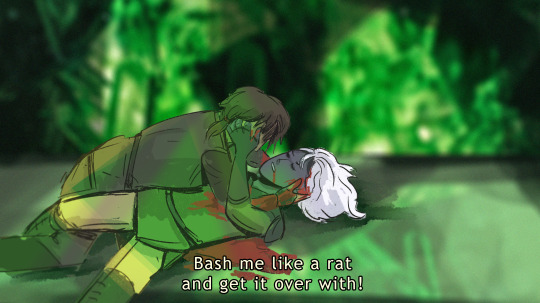

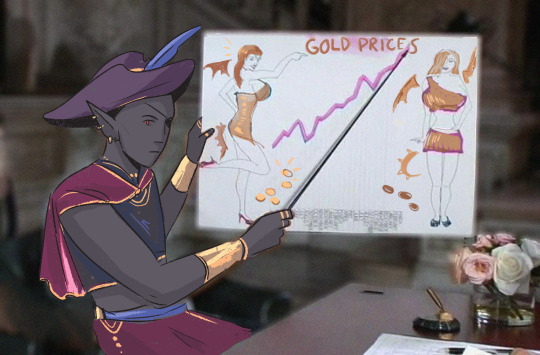
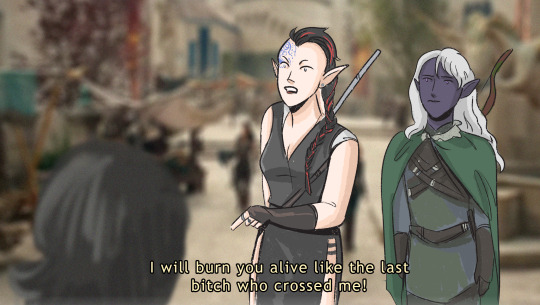
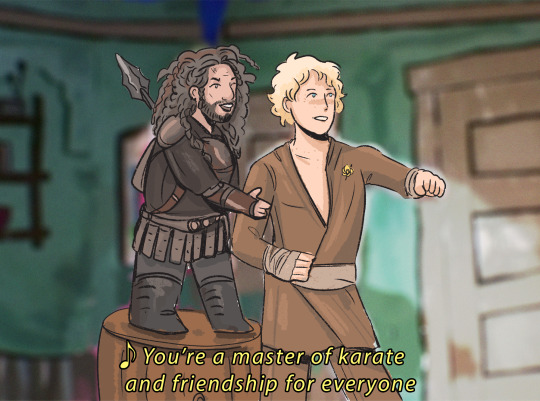

It's Always Sunny in the Forgotten Realms
(characters in alt)
#i had more memes but i ran outta steam to draw so . if you have a scene and character u think would fit. lmk#legend of drizzt#drizzt do'urden#catti brie battlehammer#bruenor battlehammer#wulfgar#regis#tos'un armgo#doumwielle#Afafrenfere#ambergris#jarlaxle baenre#kimmuriel oblodra#dahlia sinfelle#clare's art
320 notes
·
View notes
Text

John Singer Sargent
Fumée d'ambre gris (Smoke of Ambergris)
1880
(The Clark Art Institute)
#john singer sargent#smoke of ambergris#american art#american painter#art history#ambergris#portrait artist#portraiture#gilded age#american history#modernism#tumblrstyle#artists on tumblr#tumblr art#tumblrpictures#tumblrpic#tumblraesthetic#aesthetictumblr#tumblrposts#beautiful#beautiful art
336 notes
·
View notes
Text
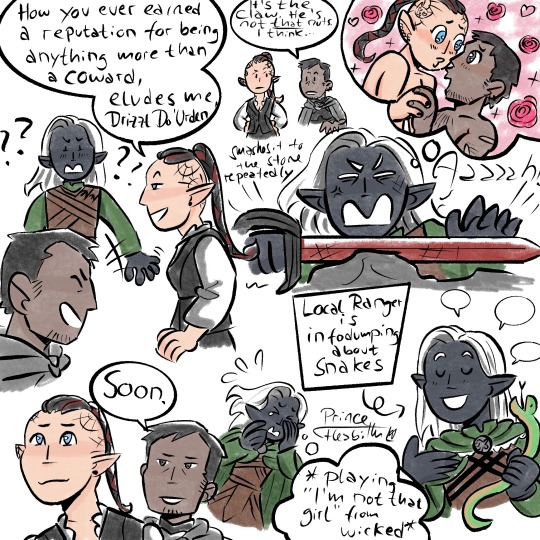
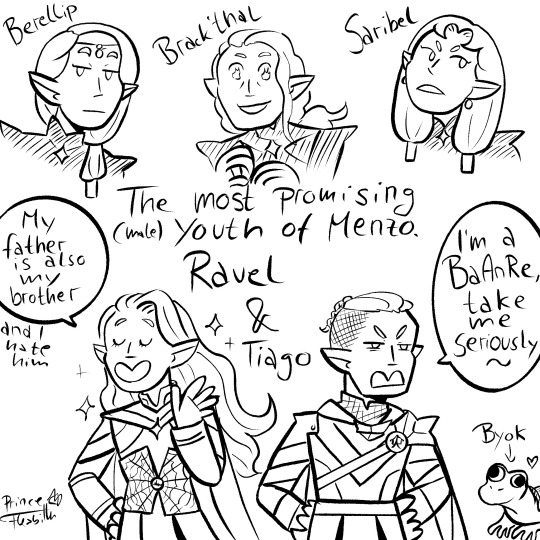


I finished reading R.A. Salvatore’s Lord of the Rings fanfiction :D (Legend of Drizzt: Charon‘s Claw)
#its love triangle time!#myart#my art#art#fanart#digital drawing#sketch#comic#drawing#digital sketch#drizzt do'urden#legend of drizzt#artemis entreri#dahlia sinfelle#lod#charons claw#neverwinter#ambergris#gromph baenre#Tiago baenre#xorlarrin#drow#Kiss#dnd#dnd art#dungeons and dragons#forgotten realms#book fanart
90 notes
·
View notes
Text
All of my recent Wet Beast Wednesday posts have been about relatively small animals, so this time let's go big. This week's topic is on the sperm whale, a winner of multiple size-based records, including being the largest toothed predator and largest of the toothed whales. These absolute units are known for their famous rivalry with giant squid and their history with the whaling industry.
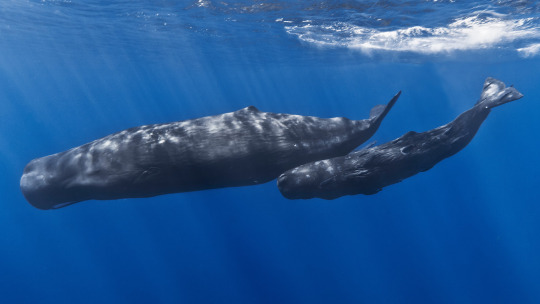
(image id: a mother sperm whale and her calf. They are both large, long, grey animals with squarish heads. The calf is behind the mother and about half the size. The calf also appears to have multiple remoras attached to it)
First of all, why is it called a sperm whale? When I started researching for this post, I thought it must be a quirk of translation or a word that changed meaning over time and surely couldn't be named after THAT sperm, right? Well, I'm sad to say that's not the case. It really is the cum whale. More specifically, it is named after spermaceti, a substance inside the whale's head, that was believed to be semen. Spermaceti even translates to "whale semen". Yeah I'm not happy about that either. Sperm whales are also called chacalots and nobody really knows why. There are suggestions that it comes from old French words for "big teeth" or the vulgar Latin word for a sword hilt. At least it's not sperm this time. Its scientific name is Physeter macrocephalus, which means "blowhole big head", which is also fortunately lacking in references to sperm.

(image id: a sperm whale seen from the font and left. It is just under the surface of the water, with the tip of its snout touching the surface.)
Sperm whales are big even by whale standards, though there are still baleen whales that are bigger. In an extreme example of sexual dimporhism, males can be 30 - 50% larger and three times as heavy as females. An average adult male reaches an average of 16 meters (52 ft) and 45000 kg (100000 lbs) while females reach an average size of 11 meters (36 ft) and 15000 kg (34000 lbs). The average sizes of sperm whales has decreased since record were first kept. This is likely a result of the largest individuals being targeted heavily by whalers, resulting in only the smaller animals being able to pass on their genes. Some recent studies suggest that trend may be beginning to reverse itself now that the animals are no longer actively hunted.

(image: two sperm whales seen from above. They are at the surface of the water, with their backs avome the surface. One of them is releasing a spout of water vapor from its blowhole)
Possibly the most notable feature of a sperm whale is that giant, square head. Cetacean heads contain melons, organs filled with oily or fatty tissue that are used in echolocation. Unlike other cetaceans, the sperm whale has two such organs: the spermaceti organ and the junk, the latter of which is analogous to the melons of other whales. The spermaceti organ is a sac filled with the spermaceti, a waxy substance composed largely of wax esters. Harvesting of the spermaceti was the main reason sperm whales were hunted as it could be used for lubrication and as candles and lamp oil. Spermaceti is liquid when within the whale and solidifies at around 30 degrees C. A single whale can hold up to 1,900 liters of spermaceti. An air tube runs through the head and ends in a pair of phonic lips (the sperm whale has a single pair while all other toothed whales have two pairs). The lips produce the clicks used in echolocation and that sound travels through the spermaceti and reflects off another organ called the frontal sac, which acts as a sound mirror. Think those satellite dishes that you can whisper into and people standing way away from you can hear it. The frontal sac reflects most of the sound through the junk, which amplified it further. The sound that does not go to the junk is reflected back and forward through the spermaceti organ to create multiple clicks with each vocalization. The spermaceti organ and junk amplify the sound of the clicks to such an extent that the sperm whale is the loudest animal on earth, capable of making 230 decibel clicks. That's louder than a jet engine at takeoff. Side note, why is a jet engine the default comparison for loud things? In addition to echolocation, sperm whales also use vocalizations to communicate with each other. Types of vocalizations are learned from parents, creating multiple distinct "dialects" of sperm whale sound. The Spermaceti organ and junk are also believed to add protective padding to the head. One hypothesis says that the spermaceti is also used in buoyancy regulation. The idea is that before a dive, the whale would pump cold water through tis head, cooling and solidifying the spermaceti to reduce buoyancy. Then on the dive, body heat and heat transfer would melt the spermaceti again, increasing buoyancy for the trip back to the surface. This hypothesis is considered poor due to a lack of evidence and the fact that solidifying the spermaceti would impede echolocation right when the whale would need it the most.

(image id: a diagram showing a side cross-section of a sperm whale's head. Most of the head is taken up by the spermaceti organ (top) and junk (below). Below the junk are the upper and lower jaw bones)
Sperm whales are master divers. They hunt in the deep ocean and of all marine mammals, only the elephant seal and Cuvier's beaked whale dive deeper. Their dives can reach up to 2,250 meters (7,382 ft) deep and can stay underwater for up to 2 hours, though most dives last around 45 minutes. To accommodate for such deep dives, special adaptations are needed. Their lungs can collapse under the pressure and their ribcages will close to protect them. The lung collapse reduced excess nitrogen intake (which can lead to nitrogen narcosis) and they can slow their metabolisms to reduce oxygen usage. Their muscles contain more myoglobin (which stores oxygen) and they more red blood cells than most animals. When oxygen levels get low, they can redirect blood flow to the brain and other essential systems. Their eyes are the largest of all toothed whales and they have good vision and sensitivity to light, helping them see in the deep ocean. Their jaws are also adapted to hunt their prey. The jaw is very skinny and has teeth only on the lower mandible. The teeth grow rings like trees, allowing them to be used to age whales. The teeth do not seem to be essential for feeding as toothless whales have been found still well-fed. They are carnivores who feed primarily on squid but will also eat octopi, bony and cartilaginous fish, and salps. While sperm whales are famous for eating giant squid, most of their diet is composed of medium-sized squid weighing between 12 and 650 grams (0.026 and 1.43 lbs). We do know they eat giant and colossal squid both from finding squid beaks in the stomachs of beached specimens and from the scars left by the suckers and hooks of the squid on the whales' skin. While classic depictions of the hunts depicted a titanic struggle between two equals, with the squid eating the whales just as the whales ate the squid. Now its believed that the fights are entirely one-sided with the whales winning the vast majority of encounters. Tagging has shown that the whales swim upside-down as they hunt. They are likely looking for the silhouettes of prey against the surface or for bioluminescence. They also hunt with echolocation. While it has been suggested that their sonar clicks are powerful enough to stun prey, recent research has show this is likely not the case. Sperm whales eat about 3% of their body weight every day. Sperm whales, as well as other deep-diving predators, help circulate nutrients in the ocean. They consume nutrients in the deep ocean, then defecate in surface waters, releasing those nutrients where they can fertilize plankton. This also helps carbon sequestration as phytoplankton fertilized by the feces remove carbon from the atmosphere and carry it to the deep sea when they die. It is calculated that whaling in the Southern Ocean resulted in a release of 2 million tonnes of carbon into the atmosphere each year.
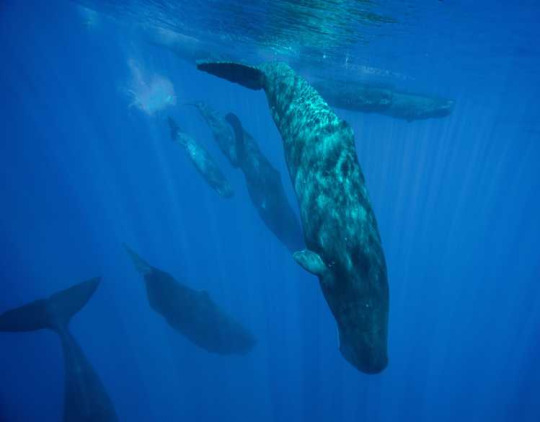
(image id: a pod of sperm whaled beginning their descent into the deep sea. There are 8 individuals, three of which remain parallel to the surface of the water. The rest and aimed downward)
Like other cetaceans, sperm whales are social animals. Females and juveniles live in groups called pods while adult males live outside the pods either alone or in small groups of other bachelors. Sperm whales who live together do so in groups called social units that are often, but not always, the same as their pod. Leaving and joining social groups is rare, leaving their membership very stable. When socializing, sperm whales use unique patterns of clicks called codas. It was formerly thought that codas were used as names, not it is now known that whales will use multiple codas. They also spend time nuzzling each other. They are also believed to use group hunting tactics to herd prey. The only predator of adult sperm whales is the orca, and they prefer to target calves or weaker adults. Orca pods will attack sperm whale pods to try to isolate a vulnerable member. Pod members will protect these vulnerable members by circling them, usually facing tail-out. The tails are capable of delivering powerful blows that could kill an attacking orca. This formation is called a marguerite formation. Lone males may come to the defense of a nearby pod under attack. On some occasions, sperm whales will swim alongside other cetations and there is a recorded instance of a pod adopting a bottlenose dolphin with a spinal deformity for unknown reasons. Sperm whales sleep together, suspended vertically just under the surface. While most cetaceans only sleep half of their brain at a time, it is possible that sperm whales can sleep their entire brain at once.

(image id: a pod of sperm whales sleeping. There are six positioned vertically in the water, with their head facing up. A seventh members remains horizontal and appears to be awake)
An individual whale can live for up to 70 years. Females reach sexual maturity at age 9 and bear a single calf at a time. The calf will nurse for an average of 19 - 42 months, but sometimes significantly longer. Sperm whale milk is extremely fatty, consisting of 36% fat (compare to 6% fat in cow milk) and has a texture like cream cheese. This high fat content helps the juvenile develop its blubber and its thickness keeps it from dissolving the the water. While giving birth, a mother will be protected by other members of her pod. After birth, other pod members sometimes jostle and bite the newborn. Most females give birth every 4 to 20 years and these rates were higher during the peak of whaling years. Females seems to become infertile in their 40s. Older, post-fertile females will lead the pods and provide assistance to younger mothers. Males provide no parental care. A male will mate with multiple females and they do fight each other for dominance and access to mates, but do not form harems. Fights seem to involve ramming each other and biting.
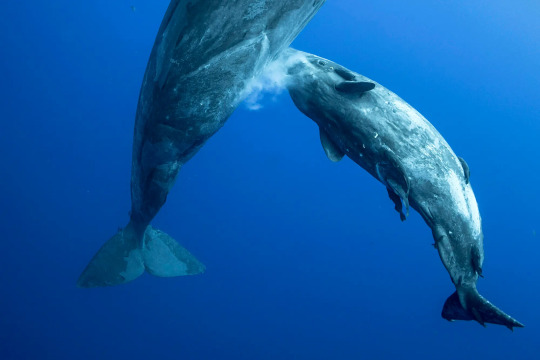
(image id: a sperm whale calf nursing. The mother is positioned vertically and her front half extends beyond the picture's frame. The calf is suckling at her side near the ventral surface. A cloud of white milk is around its mouth)
Like other whales, sperm whales were highly affected by whaling. While the spermaceti was the main target of whalers, they were also hunted for their blubber, teeth, and ambergris. Ambergris is a substance that forms in the intestines in response to irritants. The sperm whale can't digest the squid beaks and while it can vomit out a lot of them, some pass into the intestines. To prevent the sharp beaks form damaging the intestines (which can reach 300 meters/948 ft long and are the longest of any animal), the bile duct secretes the ambergris to surround the beak and ease its passage. It can be considered analogous to an oyster forming a pearl around a grain of sand. Ambergris is a think, waxy substance known for its extremely pungent, fecal smell. It was famously used as a fixative in perfume recipes and was therefore incredibly valuable. Now that whaling is much rarer, most ambergris is found when it floats to shore and perfume companies have switched over to artificial fixatives. The teeth were used for their ivory and were often carved into ornamental pieces called scrimshaw. Sperm whales were notable for their ability to fight back against the whalers, often by ramming the boats. At least a few whaling ships were sunken by their would-be targets. Famously the sinking of the whaling ship Essex inspired the writing of the novel Moby Dick. Large whales, including sperm whales, were nearly driven to extinction by whaling. The International Whaling Commission gave the species legal protection in 1985, though Japan still hunts them and has caught an reported 51 individuals since 2000.The peak of sperm whaling happened in the 1960s, causing the population to drop dangerously low. Since then, the population has been recovering and is currently estimated to be in the hundreds of thousands. Sperm whales have recovered from whaling better than many other species and are classified as vulnerable by the IUCN. Threats include illegal whaling, global climate change, and noise from ships that appears to increase beaching numbers.

(image id: a chunk of ambergris. It is an irregular object with multiple lumps. It is a pale orange color. Part of a squid beak is visible at the side, appearing as a smooth surface with a dark orange color)
jizz whale
#wet beast wednesday#sperm whale#biology#marine biology#zoology#ecology#whale#cetaceans#whaling#animal facts#ambergris#long post#pictures
137 notes
·
View notes
Text
If you like I Am In Eskew and The Silt Verses, why not try the Ambergris trilogy? We’ve got:
Mushrooms
Like so many mushrooms
A fucked up river full of fucked up squid
Tons of eldritch body horror
Unstable and obsessive artists tapping into unnatural forces in an attempt to communicate something that cannot be easily described in words
Magic-powered hell capitalism
Feuding historians
“I never lose my sense of the city’s incomparable splendor — it’s love of rituals, its passion for music, its infinite capacity for the beautiful cruelty.”
Names to rival even the great Chuck Harm
Awful cities that have something intrinsically yet indescribably wrong with them
Strange and unknown horrors that are omnipresent but uneasily ignored because to acknowledge them directly is too frightening to consider
Many, many characters who are sopping wet, pathetic, and/or unhinged in variously sad yet endearing ways
”it’s the silt, man! The silt!”
142 notes
·
View notes
Text

€500,000 worth of Ambergris found in the intestines of a beached sperm whale of the Canary islands
"In one of his many digressions in Moby-Dick, the novelist Herman Melville dedicates an entire chapter to ambergris, which he describes as 'soft, waxy, and so highly fragrant and spicy, that it is largely used in perfumery … Who would think, then, that such fine ladies and gentlemen should regale themselves with an essence found in the inglorious bowels of a sick whale! Yet so it is!'"
#mymedley#amber gris#ambergris#sperm whale#canary islands#the gaurdian#fragrance#perfume#marine life#spain#wildlife#sea creatures#moby dick#articles#science
78 notes
·
View notes
Text
I'm rewatching "Ambergris" and when Louise is talking about how they are going to sell the ambergris, she says she reached out to "the hardest, most ruthless criminal we know"- it's Mickey, of course. But if I was Critter or one of the other guys from the One Eyed Snakes and I found out about that, I'd be a little hurt. Like, those guys seem to be harder, more ruthless criminals than Mickey.
So that's Louise's real mistake in this episode: she didn't think about all of her adult criminal friends to consider who would do the best job.
Of course, as a viewer, I wouldn't trade Mickey's appearance in this episode for anything. The monkey and/or crow bar (him and Trev are totally gonna open that some day!). "Mickey tank bank!" "Seagulls! Swarm attack!" He is priceless in this one.
#bob's burgers#ambergris#louise belcher#mickey bob's burgers#critter bob's burgers#the one eyed snakes
13 notes
·
View notes
Text
no but like Amber is SO funny if you assume Kodeira is an ex
--
Amber: Hey Kodeira, can you party?
Kodeira: I think you know the answer to that...
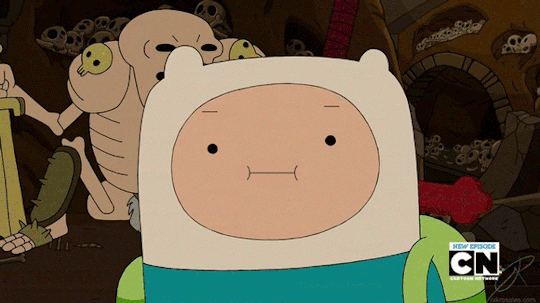
ID: A gif of Adventure time's Finn and Flame princess rapidly raising their eyebrows at each other. End ID
Amber: ...that's a no, right?
#amber: everyone in this ocean desires me carnally#taz ethersea spoilers#taz ethersea#ambergris#ballister kodeira
190 notes
·
View notes
Text

Day in Fandom History: April 20…
Tina, Gene, and Louise found a washed-up whale poop called ambergris with Louise becoming obsessed over it, mostly due to how much it cost, and tries to sell it to the black market as Bob and Linda get the bathroom renovated with the help of Mr. Fischoeder's brother. “Ambergris” premiered on this day, 10 Years Ago.
#Day in Fandom History#10 Years Ago#Bob's Burgers#Bobs Burgers#Bob’s Burgers#Season 4#Ambergris#Cartoon#Animation
3 notes
·
View notes
Text
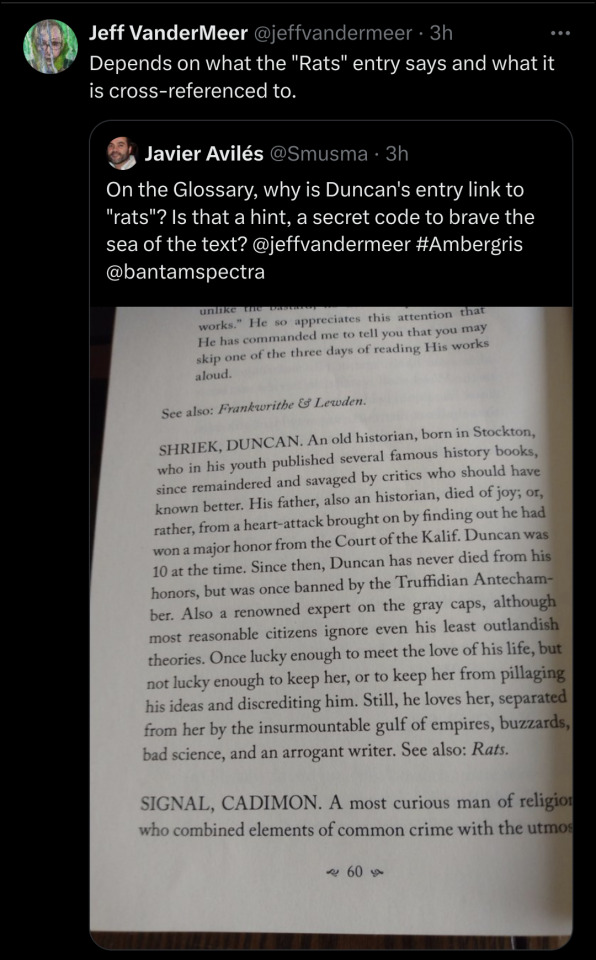
im mad that there are literally differences in the editions of City of Saints and Madmen that affect the Glossary so this may very well be true lmfao
- ace
#ambergris#jeff vandermeer#checking our two editions suggests there's no differences there at least#and that the big 'hint' there I think is that the rats section links to Lacond#meaning that's a pre-Shriek hint that pssst Duncan is writing as Lacond sometimes#still#the butterfly/fungus binary
5 notes
·
View notes
Text
I finished Jeff Vandermeer's Ambergris in the last few days. They were good, Shriek: An Afterword might be my favourite, but it's hard to compare it to City of Saints and Madmen. Mostly because CoSaM is more of an anthology, with some truly exception pieces and some made made weaker by proximity to them.
(I will add a cut here. I have written more than I expected, with more information than you might want before reading. Proceed with caution.)
Frankly, while I still loved Finch, I found its ending weak. Perhaps I will come around in later re-readings, but I can't help but feel it lacked the necessary full catharsis for the tension built up before it. Additionally, while necessary due to its premise and format, its prose and handling of the core concepts of the series felt clumsier.
It gave too much, too freely, and the presentation of this was more plain. It reduced the dread and tension to the familiar (but not mundane) and explicable (as much as is possible for such topics).
Regretably continuing to heap up negativity: There were three primary threads that failed for me. Threads that perhaps would remedy the above if they had reached me.
The thread of the protagonist's father,
The protagonist's previous identity, and
The (only sometimes) subtle villain. (Spoilers abound!)
1.
I did not connect to the emotions tied to the father past a point. I felt it held a personal significance for Vandermeer, but I do not share his history and could not find it sufficiently affecting. Not for a lack of sympathy, but empathy – it felt too close to something powerful for Vandermeer alone. (I will point out some parallels in my personal experience that could theoretically, in the most calculating and impersonal way possible, lend me the experiences needed to translate the themes; if only to better demonstrate how they failed, or how I failed them.
(My father is dying from stage four blood cancer. He has been made a pariah. He has betrayed, and been betrayed. There is love, tinted with confusion, for I can not, and may never, truly know him. I don't understand who he is or why he did what he did. He is a known quantity only in hindsight, a stranger in the present. We share a deep connection through our names, in our sympathy for each other, in the frank and bleak acceptance of the hand we have been dealt. That we are weak, limited and short-sighted men doing what we can in a vicious world.)
There is a connection, but I do not feel enough of it, and I suspect it is crucial to this story. The great reveal is buried amidst more of the same: relentless exposition and an ever-urgent escalation. It lacks the necessary 'pull back' that gives impact to such a moment -- The opportunity to take to the stage alone and reach past words.
2.
The same can be said for the protagonist's past life and identity. It lacks room to breathe, boxed in claustrophobic company with players and events too large to permit its scale.
Too much is divulged too regularly for the tightening of emotional chords, and thus resonance. We know more than is needed each time the topic becomes relevant, until what could have been crescendo arrives flat.
Just a known and expected fact among many.
Once he was James, now he is John. Once he was a bastard, now he is a different bastard. The difference between a womaniser who loves whiskey and cigars and a cynical unwilling detective who loves whiskey and cigars is not enough to merit the weight implied when this information is presented.
We know, unfortunately.
3.
Finally (and this is far more than I anticipated to write on just this one novel) is the villain.
They feel like someone has stitched them into the story after enthusiastic and misguided recommendations from the publisher (I cannot say editor, because the glamorous Ann Vandermeer is Jeff's wife and editor, and has never disappointed.).
Like using a ball of twine and a knitting needle to sew back together a rich but torn silk tapestry. It is functional in the literal sense, necessary in the mechanical, but still confusing and upsetting to see.
Risking outright spoiling everything: I felt a rush of baffled familiarity towards the end of the book.
Suddenly, I was reading the most inventive and creatively liberal written adaptation of a video game ever envisioned.
Specifically: Half-Life 2.
Now, while Shriek: An Afterword and Finch were both published after the games release, City of Saints and Madmen preceeded Half-Life 2 by over three years, if you wholly discount the time spent writing the books. More still, the whole series is too significant and developed to be informed and transformed that quickly. These are the sort of stories that take a half-decade or more to plan and build up.
I admit, I haven't read or listened to Vandermeer talk about his work, much. Just the excerpts at the ends of his novels and a few short posts, about his disappointment in Alex Garland's adaptation of Annihilation and re-wilding lawns. So perhaps he has spoken on this. I am afraid to learn if he has.
To explain more; it is not just in specifics of content that I drew connections, but in tone. Towards the end, it truly does begin to feel like the plot of a game. It becomes too abrupt, too direct and too normalised as the verisimilitude of the world shifts from horror and a languorous living city resplendent in cruelty, beauty and pleasure -- to a shallow pool of one-note characters, alien invasions and resistance to an all too comprehensible (if mindlessly evil) occupying force.
The villain itself is, well... absurdly tied in? As if they are sewn across the book to rejoin wandering scenes; to shuffle and shuttle the actors to their places in the next scene (once, very literally), and then, with a metaphorical but embarrassingly exaggerated wink to the audience, reminds us the story takes place in a world of mysteries before (again, literally!) vanishing. To which our man clumsily muses to himself (and thus us) "It sure is a scary and mysterious world we live in. Welp. Not my problem anymore."
Okay... so. This came out far more passionate a diatribe than I expected. I had wanted to quickly note the negatives before moving on to the positives, as to not leave anyone reading on a sour note. I love these books. Have loved City of Saints of Madmen for years, and I don't truly regret reading the sequels.
There is a genre in fiction that I would describe as 'The City'. I am tempted to attach 'monster', '(anti-)hero', 'protagonist', 'beast', 'ancient' or 'eternal'. But we all know these tales; in Gaiman's Neverwhere, Dishonored's Dunwall, Miéville's New Crobuzon, Bioshock's Rapture, Pratchett's Ankh-Morpork, Disco Elysium's Revachol, David Edison's City Unspoken, Jon Ware's Eskew, and any number of the countless fictional depictions of London, Hong Kong, Cold-War Berlin, Los Angeles and, of course, New York.
This "genre" is a favourite of mine. Most strongly felt when the unity and vision for their subject (of affection) is unified in vision, deeply defined, longingly familar, tantalisingly strange and unique in a ubiquity of perspective between its physical architecture and the absurd views of its inhabitants.
These are places where you can refer to both the (un)mapped streets and their citizenry as "The City" interchangeably without negating the autonomy and presence of either.
Places that cannot be described as "Like x city, but with y concept" without utter disservice.
Places that are alive and changing and wanting and hostile and loving.
Places that are cruel and ugly and comforting and utterly remarkable.
Ambergris is one such place, a paragon of its kind. It is so much more. Its paths are winding and beautiful and deeply unsettling. It is wrong in all the right ways. It is a cathedral built in the mind, a channel of lasting silences and roaring senses flowing through them. It is a place no one has ever been, that lives now inside me.
It really is something.
"If you don't feel a certain sadness toward the past, then you probably don't understand it."
#jeff vandermeer#finch#city of saints and madmen#shriek: an afterword#ambergris#book review#I suppose?
10 notes
·
View notes
Text

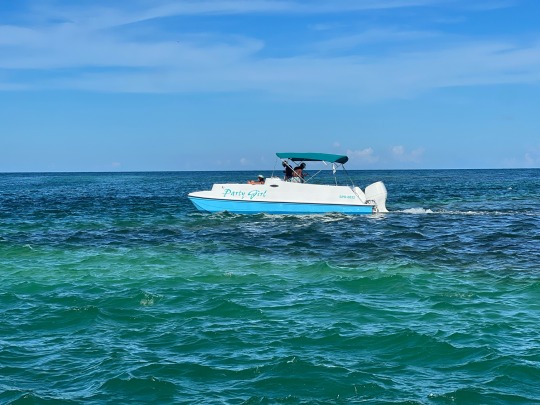


caye caulker, belize c.a.
#belize#caribbean#caye caulker#the cayes#belize city#guatemela#honduras#garifuna#beach vacay#vacation#sea#ocean aesthetic#ocean view#island living#island life#mayan culture#aztec culture#cayo#ambergris#ambergris caye#coral reef#coral#diving#sailing#boating#travel#travel Belize
7 notes
·
View notes
Text
Let’s say, sometime in your twenties, you find it necessary and desirable to change your name, and the name Electra calls to you. Except that you decide that’s too short and not significant enough, and you change your name—legally—to Electrocardiogram. You like the machines that make them, you like how they beep, you find personal significance in aspects of their relations to our hearts and heartbeats and the impermanence of life. But everyone just calls you Electra.
Now it is a while later and you realize you’ve never actually TAKEN an electrocardiogram, and you’d like to buy one of the machines that make them. Assume for this scenario that they are affordable and practical objects. But the only people willing to sell them to you run a small online shop where they take your card details down manually. If you pay these people for an electrocardiogram machine, they are going to see that your name is literally, legally, electrocardiogram, a name no one else has. What are they going to think? What do you do? How do you explain this?
This is a real question I am trying to buy ambergris and I’m starting to worry that the name on my debit card is going to weird out the wholesalers 😭
#ambergris#globally unique name#I know some character from the adventure zone had this name but it’s not all one word and anyway they are fictional#I also found out after the fact that amber was historically a word for ambergris#the fossilized resin was named after the perfume ingredient not the other way around#it’s from the Arabic عنبر which i like since I’m trying to learn the language
6 notes
·
View notes
Text

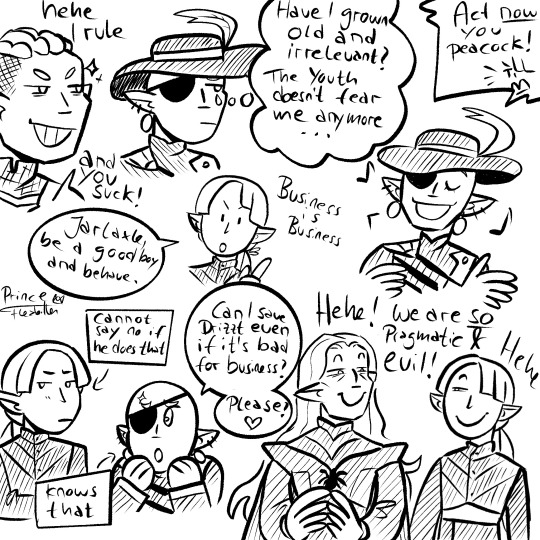


R.I.P. Drizzt (Sketches for Legend of Drizzt: The last Threshold) see you in the next book I guess
#the king is dead long live the king#no that was something else😂#myart#my art#drawing#fanart#digital drawing#comic#sketch#the legend of drizzt#legend of drizzt#drizzt do'urden#ambergris#jarlaxle baenre#bregan d'aerthe#gromph baenre#kimmuriel oblodra#Tiago baenre#Brother afafenfere#artemis entreri#effron alegni#dahlia sinfelle#saribel xorlarrin#ra salvatore#forgotten realms#dnd#dnd drow#neverwinter#lod the last threshold#dungeons and dragons
65 notes
·
View notes
Text
The thing w amber's portal diving is that it was in some ways the only narrative option-- it's a chance to show that koda's choices we a false dichotomy. Justin pointed out as much! Blink sharks Are Magic-- the world has a native, non-aggressive magic that isn't any more destructive than its other fauna. Going through the portal opens up exploration! Intrigue! More sharks! The prophecies have been fulfilled- she hurtled through the sky like a fireball- but she's not bringing about the end of any world imo. She's asking a question for next season to answer.
58 notes
·
View notes
Text
Goddamnit, hate it when the love of my life ends up being a doll in the upstairs window of the mercantile.
15 notes
·
View notes